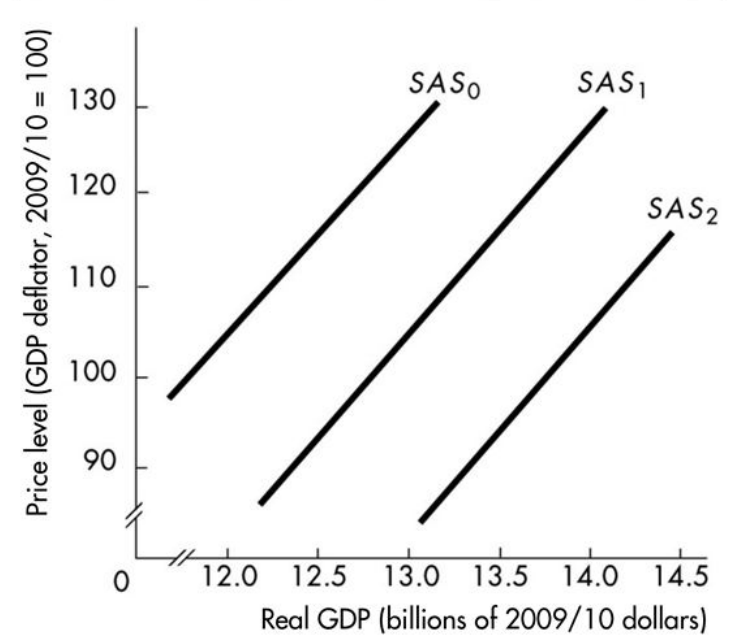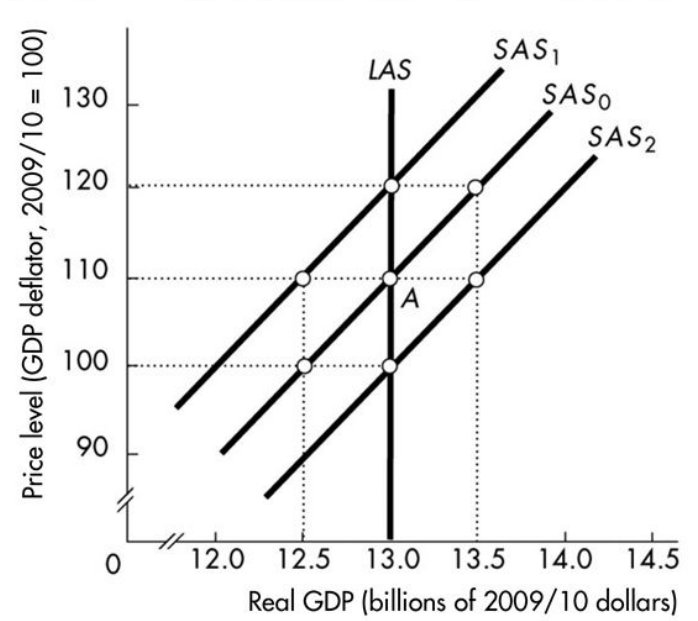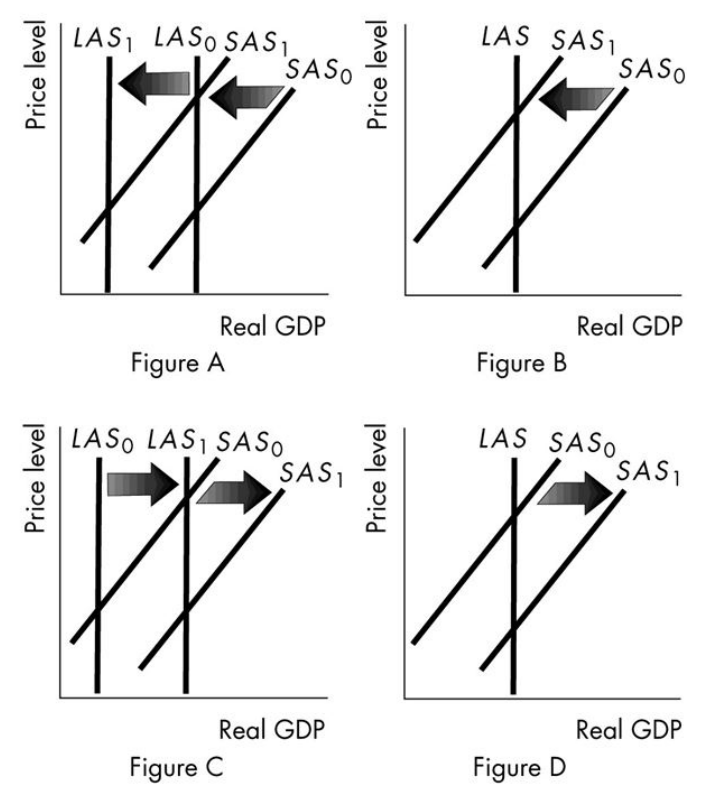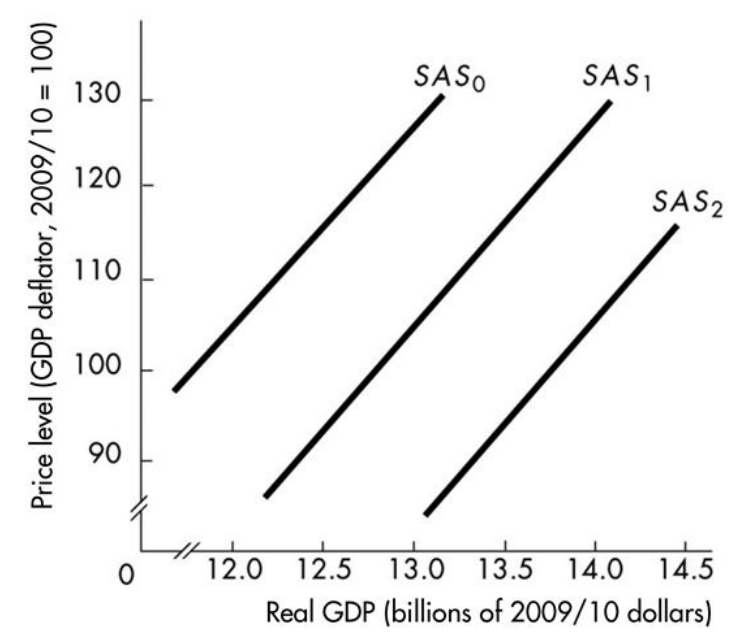A) technological progress.
B) an increase in the money wage rate.
C) an increase in the stock of human capital.
D) a change in the capital stock.
F) A) and B)
Correct Answer

verified
Correct Answer
verified
Multiple Choice
Keynesian macroeconomists recommend
A) policies that actively offset the changes in long- run aggregate supply that result in negative economic growth.
B) policies that minimise the disincentive effects of taxes on employment, investment and technological change.
C) policies that actively offset the changes in aggregate demand that bring recession.
D) an increase in the quantity of money to offset decreases in aggregate demand and a decrease in the quantity of money to offset increases in aggregate demand.
F) None of the above
Correct Answer

verified
Correct Answer
verified
Multiple Choice
 -In the above figure, the short- run aggregate supply curve is SAS1. If technology advances, there is
-In the above figure, the short- run aggregate supply curve is SAS1. If technology advances, there is
A) a downward movement along SAS1.
B) a shift to SAS0.
C) an upward movement along SAS1.
D) a shift to SAS2.
F) A) and C)
Correct Answer

verified
Correct Answer
verified
Multiple Choice
The long- run aggregate supply curve is vertical because
A) at full employment prices are stable.
B) there is no cyclical inflation.
C) the money wage rate increases faster than the price level.
D) potential GDP is independent of the price level.
F) A) and B)
Correct Answer

verified
Correct Answer
verified
Multiple Choice
 -In the above figure, the economy is at point A. Then the price level falls to 90 while the money wage rate does not change. Firms will be willing to supply output equal to
-In the above figure, the economy is at point A. Then the price level falls to 90 while the money wage rate does not change. Firms will be willing to supply output equal to
A) $13.0 billion.
B) more than $13.0 billion.
C) less than $13.0 billion.
D) Without more information, it is impossible to determine which of the above answers is correct.
F) B) and C)
Correct Answer

verified
Correct Answer
verified
Multiple Choice
________ economists believe that active help from fiscal and monetary policy is needed to ensure that the economy is operating at full employment.
A) Classical
B) Keynesian
C) Monetarist
D) All
F) C) and D)
Correct Answer

verified
Correct Answer
verified
Multiple Choice
Which of the following events will increase short- run aggregate supply?
A) An increase in foreign income
B) An advance in technology
C) An increase in the natural unemployment rate
D) An increase in resource prices
F) A) and C)
Correct Answer

verified
Correct Answer
verified
Multiple Choice
Technological progress will
A) shift the SAS curve rightward but will not shift the LAS curve.
B) shift both the LAS and SAS curves rightward.
C) shift the LAS curve rightward but will not shift the SAS curve.
D) not shift either the LAS or the SAS curve.
F) A) and C)
Correct Answer

verified
Correct Answer
verified
Multiple Choice
Which of the following events will increase long- run aggregate supply?
A) An advance in technology
B) An increase in resource prices
C) A decrease in expected profit
D) An increase in the interest rate
F) B) and C)
Correct Answer

verified
Correct Answer
verified
Multiple Choice
 -In the above figure, which point corresponds to an increase in technology?
-In the above figure, which point corresponds to an increase in technology?
A) Figure A
B) Figure B
C) Figure C
D) Figure D
F) All of the above
Correct Answer

verified
Correct Answer
verified
Multiple Choice
 -In the above figure, the short- run aggregate supply curve is SAS1. Suppose that the price level in the economy increases. As a result there is
-In the above figure, the short- run aggregate supply curve is SAS1. Suppose that the price level in the economy increases. As a result there is
A) a downward movement along SAS1.
B) a shift to SAS0.
C) a shift to SAS2.
D) an upward movement along SAS1.
F) None of the above
Correct Answer

verified
Correct Answer
verified
Multiple Choice
One reason that the aggregate demand curve has a negative slope is because
A) people buy more foreign goods when the domestic price level rises.
B) firms supply less when prices rise.
C) firms supply more when prices rise.
D) the amount of money in the economy increases when the price level rises.
F) A) and D)
Correct Answer

verified
Correct Answer
verified
Multiple Choice
According to the intertemporal substitution effect, when the price level rises and other things remain the same
A) the interest rate falls.
B) the quantity of money increases.
C) government taxes rise.
D) the interest rate rises.
F) C) and D)
Correct Answer

verified
Correct Answer
verified
Multiple Choice
The intertemporal substitution effect refers to the substitution of
A) goods and services today for goods and services in the future.
B) goods and services produced domestically for goods and services produced in another country.
C) goods for services.
D) goods and services for less expensive goods and services.
F) B) and C)
Correct Answer

verified
Correct Answer
verified
Multiple Choice
The aggregate demand curve shows
A) the quantity of real GDP demanded at different price levels.
B) that real income is directly (positively) related to the price level.
C) total expenditures at different levels of national income.
D) All of the above answers are correct.
F) C) and D)
Correct Answer

verified
Correct Answer
verified
Showing 141 - 155 of 155
Related Exams